“What tree is that?” The answer was “I don’t know.” That’s something I don’t say as much as I used to but when you don’t know you don’t know. Fortunately a couple of people in the class did know: Tamarind.
We were in Dreher Park in West Palm Beach. That explained a lot as Tamarind, Tamarindus indica, is from warm Africa. Today it is commonly found in South Asia and Mexico. India is the world largest producer of the legume… hmmmm… pod. And the two trees were heavy with ripe pods. It was the first time over several years I was at the park at the right time to see them. Timing is often everything.
Tamarind’s nutritious pods are consumed raw and cooked and is one of the current flavor darling of many avant-garde restaurants. The flavor is distinctive, both sweet and sour. The tree itself is slow-growing and long- lived. Without the pods it’s just another pea tree, of which there are so many here in Florida. But the next time I’m asked “what tree is that” I’ll have an answer.
While on the topic topical I carried a couple of Sea Almond seedlings home with me from West Palm Beach. They won’t survive the winters here unless taken inside so I put them in moveable pots. As such I don’t think they’ll be much an invasive threat here. Two hundred miles to the south it’s a different story. Though an attractive edible it’s on the state’s hit list. The seeds float up from Central and South America and are a common beachcomber find. During class this last week we cracked several of the “almonds” and enjoyed the tasty seed inside. The unripened green seed pods are also reported as edible but I haven’t been able to make them so as of yet. Also called the Tropical Almond, to read more about the tree click here.
As a new disciple of recumbent biking I rode 30 miles on the West Orange Trail one morning last week taking pictures from a closer-to-the-ground perspective. While there was the usual foliated forest to see a couple of plants did stand out. One was a persimmon jumping the ripening season by three months. They usually don’t golden up locally until around October, which is also long before any frost. The other plant was the Silk Bay, Persea humilis. I have personally seen it growing only on the Central Florida Ridge. (Yes there is a Central Florida Ridge, low as it is. Interstate 4 travels along a good portion of it as do most of the disruptive sink holes.) Like two other relatives, P. palustris and P. borbonia, the leaves of P. humilis can be used like a bay leaf. What makes the Silk Bay striking, and easy to identify, are the back of the leaves: They are bronze-colored. To read more about the Bays go here. You can also read more about bike trip and pictures on the Facebook page: The Green Deane Machine.
Upcoming Foraging Classes:
Saturday, July 25th, Boulware Springs Park, 3420 SE 15th St., Gainesville, FL 32641 9 a.m.
Sunday, July 26th, Jervey Gantt Recreation Complex, 2390 SE 36th Ave., Ocala, FL, 34471, 9 a.m.
Saturday, August 1st, Wickham Park: 2500 Parkway Drive, Melbourne, FL 32935-2335, 9 a.m.
Saturday, August 8th, Bayshore Live Oak Park, 23000 Bayshore Rd., Port Charlotte, FL 33980, 9 a.m.
Saturday, August 29th, Mead Garden: 1500 S. Denning Dr., Winter Park, FL 32789, 9 a.m.
Saturday, September 5th, Colby-Alderman Park: 1099 Massachusetts Street, Cassadaga. Fla. 32706, 9 a.m.
To learn more about classes go here.
Need to identify a plant? Looking for a foraging reference? Maybe you have a UFO, an Unidentified Flowering Object, you want identified. On the Green Deane Forum we — including Green Deane — chat about foraging all year. And it’s not just about warm-weather plants or just North American flora. Many nations share common weeds so there’s a lot to talk about. There’s also more than weeds. The reference section has information for foraging around the world. There are articles on food preservation, and forgotten skills from making bows to fermenting food. There was a recent link to the newest list of edible insects. Recent topics include: Fern? Elderberry Blossoms. Edible Insect PDF. Eggs in the Hopper. Holes in Blackberry Leaves. Removing Urushiol (Poison Ivy.) Great Ragweed, Another NJ Tree, Tree South NJ, Cultivated Flowers, Pawpaws Almost Ripe, Cross Wine, Quite the Taproot, Venation is Plantago-esque, Sumac? Unknown Ornamental, Pipsissewa uses? Artemisia douglasiana, Smilax, Yet Another Vine, Is This Cilantro or some kind of nettle? Mulberries as far as the eye can see and Becoming a Wild Food Expert. You can join the forum by clicking on the button on the upper right hand side of this page.
Are the seasons changing? Whether there is global warming and whether it is man-made will probably be arguments we will hear for decades. But one thing seems to be so, and that is the seasons are changing though perhaps irrationally. Two plants come to mind. One is the Podocarpus, a common hedge plant locally. I used to be able to count on it having fruit in August. Now I can find it as early as June and as late as December. More shocking is Pellitory. It was a cold-season crop, much like stinging nettles. I would start looking for it around Thanksgiving and it would disappear around St. Patrick’s Day. Saturday, July 18th, I found some in West Palm Beach. Not only out of season, but in a warm area of the state. Then again, it was growing under a Banyan, the same tree I found Honey Mushrooms growing under about a month ago, again out of season. These might be normal variations or perhaps things are changing though the effects are a bit unusual. To read more about Pellitory go here.
This is newsletter #170. To subscribe to Green Deane’s weekly EatTheWeeds newsletter, go to the upper right side of this page.

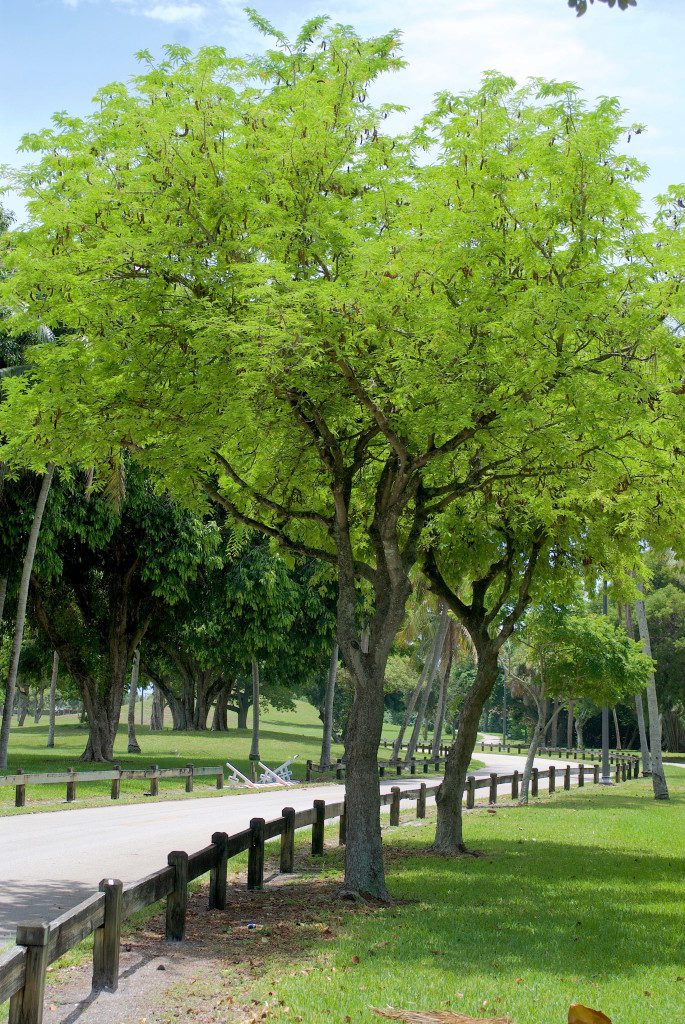
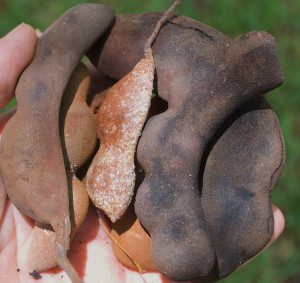
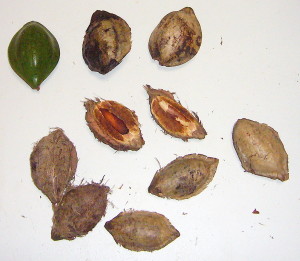
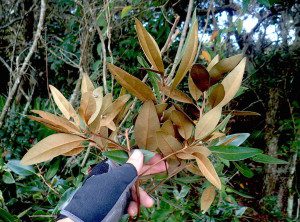
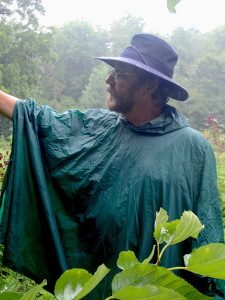
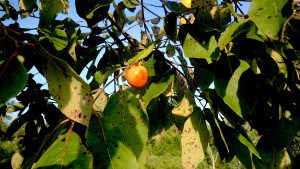


I was raised in the woods and swamps of N.J. where I was born 80 years ago. Reading your newsletter is fascinating – it jogs my memory. We foraged quite a bit as we were poor. But we were also “dirt rich” and could grow a lot of stuff which we canned. (No slackers in OUR house!) rom the littlest to the oldest, we worked! Most kids today are too lazy.
Yeah they’re lazy… partly because they are undernourished but sick and fat and suffering from our fake, toxic, American diet. We need to get back to just what you are talking about for so many reasons!
Aloha Green Deane!
I was just picking tamarind! am actually going to be cooking up kiawe (Prosopis pallida) beans with tamarind and maybe some Hawaiian chili’s today! experimenting. Here in Hawai’i I have found some really old, large sea almonds (Terminalia catappa), and there were a few times where the flesh on the outside of the corky seedpod -my botanical lingo could use an update- turned purple and pink and actually had a little substance to it. In the Caribbean I found pinkish and yellowed flesh on the outside, but it wasn’t as exciting an edible as the ones I’ve found in Hawai’i.
Is the climate changing? Probably. Of course, if it starts changing for those of us who live now, it could be a big deal if it changes too suddenly. We’ve lived at our place in NW Arkansas for over 40 years and haven’t noticed any consistent climate changes. Scientists tell us the Sahara Desert was once a lush land of vegetation about 5,000 years ago and within centuries the climate changed. Glacial ages have supposedly occurred as well and Europe once had a warmer climate than now so scientists report. And who knows what the climate was like in the area YOU live in back in 8015 BC? Some scientists think magnetic pole shift can cause climate change, as well as the activity of the sun. Like you said, Green Deane, we’ll probably be debating the climate issue, man-made or natural (or both) for decades to come. As for me, after reading that a magnetic pole shift could cause the climate here in Arkansas to be more conducive to raising tropical fruits, I was thinking how fun that would be! Who knows? We humans know so very little and think we know so much.
Another possiblity is that a number of these plants, and the honey mushroom fungi, area adapting to warmer areas and seasons.
As always, deepest appreciation for your videos, website, and
newsletters.
So what is the plant in your picture from the forum? It looks like one on my property that I’ve been searching the in the forum for already. Thanks!
The orange fruit or the twin green leaves?
The orange. I had a ripe one fall off my tree this week and – yay! – I think I have an American Persimmon.
In the year 1994 I’ve written the following summary on Tamarindus indica in my book “ Quotoof Min Ryad El Keemya – Arabic version of: Flower Clusters from Gardens of Chemistry ” which unfortunately has’nt been widely distributed. It is about the use of the fruit locally called “Aradaib” in healing malaria. The story was told by a famous Sudanese physician working in the hospital of Gedarif – eastern Sudan where “seasum” and “dura” as main crops are well cultivated by rain water. Doctor H.S.Goreish himself and many malaria indicted patients have been cured and recovered by drinking the syrup of “Aradaib” prepared according to a simple procedure. The incidence was reported in the “Arab Medical Bulletin vol. 5 yr.1983/84 – Khartoum.” It was reported that this treatment proved more successful than drugs such as chloroquine sulphate, quinone or even fanisdar used at that time and to which the parasite had become resistant. It was claimed that T. indica fruit contains the following constituents: besides citric, tartaric and malic acids, potassium, gum, pectin, some invert sugar and fibre. Interestingly, the physician has also recovered from “acid burn in the eosophagus ”from which he was continuously complaining.
Another important use of the fruit of T. indica is in the locally called “Hilo – mur” beverage taken by almost all Sudanese during breakfasting in the whole fasting month of Ramadan (a week ago we’ve been celebrating the three days of Muslims’ small biram “Eid el Fitr” just after the end of Ramadan). “Hilo – mur” means sweet as well as bitter at the same time. People get ready even a month in advance of Ramadan preparing the cake and consequently the baked flakes which when soaked in water give rise to a brownish red drink. The cake is made of a mixture of mainly “futreeta” dry sprouts sorghum flour, T.indica fruit, some spices important of which is powder of rhizomes of Alpinia officinarum also known as “Galangal”. What characterizes this drink is that one gets the feeling of being healthy and comfortable specially after eating ; no doubt it is effective in digestion. Moreover, it is known that the flakes of “hilo – mur” can be stored for years without deteriorating and be useful as if freshly made.
Well, look out because now some scientists are announcing we’re entering an ice age, just like they said in the ’70s. To be honest, when they can get the temperatures right for next week, I’ll believe their long-term predictions.
The warming period during the Middle Ages was one of the most productive agricultural periods in European history and led to less starvation. But during the Maunder Minimum, which slowly began around 1500 and last into the 1800s there was an increase in hunger as plants wouldn’t grow as well and all the vineyards in England died.
I’d rather have warming than cooling. During cooling, you can’t grow as many plants and it takes more resources and money to keep warm.
Accurate short-term forecast would add needed credibility to their long-term forecasts. I can remember well the mini-ice age that was announced during the Carter administration. It was a serious global problem….
Hilarious and so true! I love when they are still predicting sunny skies … and it’s been raining for the past 2 hours!
the tamarind has beautiful flowers in profusion too. i have heard its use in india inspired bbq sauce, of which it is a chief ingredient. mixed with citrus, who said florida is not part of the south because it has no bbq style?
I have a few seedlings I planted, but I hear they are slow growing so I doubt I’ll see them bear in my lifetime, but they are fun to watch all the same! My grandkids thought tamarind was like “sweet tarts” candy, with pits! LOL.